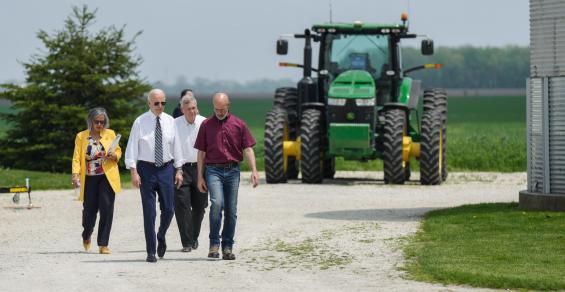Coverage will be expanded or streamlined in over 1,500 counties to double crop soybeans and sorghum behind wheat.
In May, Secretary of Agriculture Tom Vilsack joined President Joe Biden at the O’Connor farm in Kankakee, Illinois, to announce a series of actions to help farmers expand production, specifically with a promise to expand crop insurance for farmers who double crop.
“Today, USDA is making good on one of those commitments and making it easier to plant double crops and sharing some of the financial risk by making crop insurance more available in over 1,500 counties,” Vilsack said in a statement July 12 in announcing the changes under the Risk Management Agency division of USDA.
“We live in a challenging time, but I put my trust in the American farmer and U.S. agriculture to help keep the food we need affordable and available,” Vilsack says. “The Biden administration and USDA will continue to find ways to ease burdens on American farmers and lower costs for American families such as expanded double crop options through crop insurance.”
Coverage will be expanded or streamlined in over 1,500 counties to double crop soybeans and sorghum behind wheat. RMA is also working with the crop insurance industry and farm organizations to help streamline and improve the written agreements for farmers who are outside the areas where coverage has been expanded.
For soybeans, double crop coverage will be expanded to or streamlined in at least 681 counties, including all of those that were initially targeted for review. While some additional counties were permanently added to be double crop counties, the majority of expansion removed barriers such as requiring production records and streamlined the process to get personalized coverage through a written agreement.
Related: From Illinois farm, Biden announces fertilizer, double crop efforts
For grain sorghum, double crop coverage will be expanded to or streamlined in at least 870 counties that were initially targeted for review. Similar to soybeans, most of these changes included streamlining the administrative burden and requirements to obtain written agreements. Written agreements provide the producer with the maximum flexibility by allowing them to obtain crop insurance coverage, but not requiring the coverage of both the spring and winter crops as in permanent double crop counties.
RMA will also work with the crop insurance industry and farm organizations to highlight the availability and improvements in written agreements as an option for any farmer that grows a crop outside the area where a policy is automatically offered.
This expansion of coverage was guided by extensive outreach to nearly 70 grower groups covering 28 states, RMA says. This includes a wide array of stakeholders such as producers, agents, university extension and other agricultural experts, commodity associations, state departments of agriculture and insurance companies.
USDA may add additional counties as it explores these options with farmers this summer, with the final rules being locked in by the fall. Since farmers need to plan ahead for adding a winter crop to a rotation, USDA wanted to make sure they had time to consider this option and consult with local extension and agriculture experts and their crop insurance agent.
Picture this: Biden on the farm
Industry groups such as the American Soybean Association and National Association of Wheat Growers welcomed the action. ASA has urged RMA to adjust the geographic line northward for producers to be eligible to insure double cropped soybeans.
“This announcement provides farmers greater access to crop insurance, an important risk management tool,” says ASA President Brad Doyle of Arkansas. “We are pleased USDA is moving forward with the next steps to expand availability for the 2023 crop year after receiving input directly from farmers and throughout our soy states.”
“Crop insurance provides a critical risk management tool for wheat growers, and today’s announcement will help expand availability for the double cropping opportunities in 2023,” says NAWG President and Washington state wheat grower Nicole Berg. “NAWG appreciates the administration for taking the thoughtful and moderate approach to examine where double crop insurance opportunities are available across the United States.”
Berg says the announcement is particularly timely to help farmers, agents and companies become familiar with administrative changes and make the necessary adjustments.




